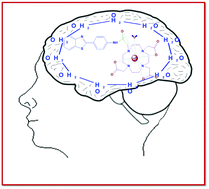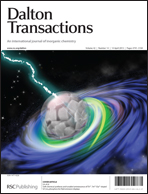Magnetic resonance (MR) imaging is widely used in clinical research to map the structural and functional organization of the brain. We have designed and synthesized a Gd-based specific MR contrast agent that binds to regions in the brain. The presented compound {4-[(4-benzothiazol-2-yl-phenylcarbamoyl)-methyl]-7,10-bis-carboxymethyl-1,4,7,10-tetraazacyclododec-1-yl} acetic acid (DO3A-BT) was synthesized by conjugating the chloroacetylated product of 4-benzothiazol-2-yl-phenylamine with a trisubstituted cyclen. The lanthanide complex (Ln–DO3A-BT) was evaluated in vitro for both MR (Gd–DO3A-BT) and optical (Eu–DO3A-BT) imaging applications. The complex Gd–DO3A-BT displays a relaxivity of r1 = 4.18 mM−1 s−1 at 4.7 T which is 1.2 times greater than Dotarem and significantly higher than the brain specific MR contrast agent Luxol Fast Blue (LFB). The protonation constant of the ligand (pKa1 = 9.91, pKa2 = 8.22, pKa3 = 5.01) and the stability constant of the complex formed between Gd(III), Eu(III) and Ca(II) and ligand DO3A-BT (log βGdL = 18.4, log βEuL = 18.3, log βZn2L = 7.1, log βCa2L = 6.3) were recorded by potentiometric titration. The constants reflect the high stability of the ligand with lanthanides compared with endogenous metal ions. The transmetalation stability of Gd–DO3A-BT toward Zn proved to be excellent with a rate constant of 3.07 × 10−5 s−1 which is in line with other tetraazatetraacetic acid (DOTA)–monoamide complexes. The hydration number (q) was found to be 0.92, and is calculated from the difference in the luminescence lifetime of Eu–DO3A-BT in H2O and D2O solutions to determine the coordination state of this complex. The in vivo biodistribution of 99mTc–DO3A-BT in BALB/c mice showed a brain uptake of 1.2% ID g−1 at 2 min post injection when injected with mannitol which disrupts the blood–brain-barrier (BBB) due to osmotic shock. In vitro binding on the brain homogenate revealed a high uptake by the neuronal/glial cells for in vivo applications.

You have access to this article
 Please wait while we load your content...
Something went wrong. Try again?
Please wait while we load your content...
Something went wrong. Try again?


 Please wait while we load your content...
Please wait while we load your content...